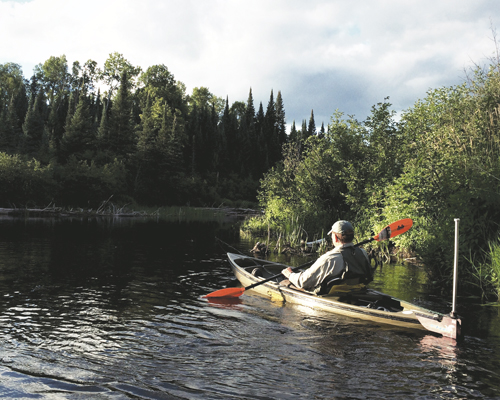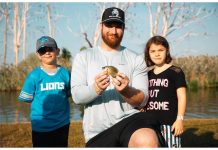
At first glance, M-72 may look just like any other highway. But it begs you to take a deeper look. This is no ordinary road. Itās a gateway for those in search of a true northern Michigan experience.
Fly fishermen, in particular, are well-acquainted with M-72. And for good areason. It is the major thoroughfare through a rugged, forested landscape that has spawned some of the most cherished trout streams in the Midwest. This is the land of the fabled Au Sable and Manistee rivers, considered āholy waterā by trout anglers, near and far.
But there are others. M-72 provides easy access to the Pine River in Manistee National Forest, the Boardman River (known for its lunker brook and brown trout), the underappreciated Rapid River, and countless tributaries holding trout. In fact, M-72 gets anglers within casting distance of about a dozen blue ribbon trout streams, a designation reserved for only the highest-quality streams.
One of only three state trunklines that crosses the Lower Peninsula from coast to coast, M-72 begins in the harbor town of Harrisville, with its cottages perched along Lake Huron. It then travels westward, jagging slightly north and south at points, until it finishes at the foot of majestic sandy bluffs that rise high above Lake Michigan in Sleeping Bear Dunes National Lakeshore.
In between those scenic bookends, M-72ās roughly 150-mile course connects northern Michigan towns including Mio, Grayling, and Traverse City. Each has a deep connection to the outdoors.
Traverse City, northern Michiganās largest city known for its fine dining and summer homes, is also a river town. The Boardman slices right through town before emptying into Grand Traverse Bay. Itās not uncommon to see anglers in pursuit of trout and salmon lining the river banks downtown, a block away from throngs of shoppers and diners.

Photo by P.A. Rech
The lure of trout has attracted adventure seekers to nearby rivers and forests for many generations. Itās not difficult to find the solitude that captured the imagination of a young Ernest Hemingway, and provided the foundation of some of his early writings. Countless writers have followed in Hemingwayās footsteps, offering their own narratives about exploits on the pristine streams.
Grayling, located at the junction of M-72 and I-75, is the epicenter of this world. Named for the beautiful fish that was extirpated by overfishing and logging by the early 1900s, the town is a trout fishing mecca. The legendary Au Sable River flows through the heart of town, and in its waters dwell the brown trout, brook trout, and rainbow trout that occupy the dreams of so many anglers.
Grayling is the birthplace of Trout Unlimited, a national conservation organization. It is also home to Anglers of the Au Sable, a group of about 800 anglers and river stewards who fight to protect the river from development and other encroachments.
This town of about 1,900 residents has a couple must-stops. The landmark Old Au Sable Fly Shop is located just a few feet from the river. Anglers come to purchase fly fishing gear and get reports on the current insect hatch, which they will try to match with their artificial flies.
Also, be sure to stop in at Spikeās Keg oā Nails, an old-time saloon where anglers come to brag about the big lunkers they caught (or more likely the ones that got away). If youāre nice to the waitress or bartender, you might get a tip where to find a good fishing hole. Perhaps not. Either way, Spikeās is an authentic place to get a burger and a beer.
If you really want to experience why the Au Sable has captured the imagination and loyalties of so many anglers, writers, and nature lovers, head just east of town on M-72 and then turn north on Stephan Bridge Road. There, at the intersection of the river, you will find the Gates Au Sable Lodge and fly shop. It is located on a hallowed stretch of river known as the āHoly Waters,ā a 9-mile section where fishermen can use only artificial flies and must release all the trout they land.
You will be hard-pressed to find a finer stretch of river anywhere in the country. But donāt take our word for it. Using a county road atlas and an adventurous spirit as your guides, the odds are pretty good youāll discover an equally beautiful stretch of river along M-72.
And perhaps even land a trout or two.

There And Back Again
Can a first-of-its-kind golf course continue to help reverse Forest Duneās fortunes?
By Steve Wilke // Photography by Brian Walters
Since it opened in 2002, Forest Dunes Golf Club has been one of Michiganās most lauded golf courses. Itās also had a history of financial trouble.
But last year, the club opened a reversible course called The Loop ā and itās adding a new twist to the tale.
The property has a somewhat checkered past. Once owned by GM founder William Durant, he sold a parcel to Detroit Mafia āinvestors.ā According to legend, their South Branch Ranch was frequented by Jimmy Hoffa.
One of Forest Dunes problems stemmed from its location ā or lack of one. Even though itās inside the Huron National Forest, itās in Roscommon. Which, tourism-wise, is basically the middle of nowhere.
Yet back in the mid-1990s, some Arizona developers decided it was just the place for an upscale golf course. It just didnāt work out all that well. At least at first.
The original Forest Dunes course is a Tom Weiskopf-designed gem. The developers had visions of folks plunking down major bucks to build vacation homes near a world-class golf course. But Roscommon is not Traverse City ā¦ or Charlevoix ā¦ or Petoskey ā¦
The course got built. But it foreclosed even before it opened. In 2002, Forest Dunes reopened under ownership of the Michigan Carpenters Pension Trust Fund (one of the original lenders). It immediately began racking up accolades. It cracked Golf ĢĒŠÄvlog°²×æ°ęās Top 100 Public Courses list. In 2003, it was named Best New Upscale Public Course by Golf Digest. It has graced the ābucket listsā of major golf publications ever since.
The Forest Dunes moniker is appropriate. Not surprisingly, there are forests. And there are dunes. There are unforgettable holes. āGambleā and āDecisionā are classic risk-reward holes that tempt you to either go for it or play it safe. āHellās Acreā is a truly evil par-3 with a wicked carry over a moonscape-like dune area.
Over the years, they added amenities like a 20,000-plus-square-foot Adirondack lodge. But the place still struggled. Even bringing in Troon ā a premier luxury golf course management company ā didnāt help.
Enter Lew Thompson, an Arkansas trucking company owner who bought Forest Dunes before the 2012 season. He built a 14-room lodge to entice guests to stay and play. But there was this nagging problem: not many other top-notch golf options in the area. Most golfers wonāt stick around and replay one course day after day, no matter how good it is. But to play two (or three) bucket lists in one trip? Thatās another story.
Enter Tom Doak. The Michigan-based golf course architect had long toyed with an idea. What if you could build two courses for the price of one? He proposed a fully reversible 18-hole course. Doak got the go-ahead from Thompson, and the rest (they hope) is history.
Last summer, The Loop opened for play. The idea is not as simple as it sounds. One day you play clockwise (the Black Course). The next day, you play counter-clockwise (the Red Course). Each is not simply a reverse, it looks and plays completely differently.
So far, so good. The Loop followed in Forest Dunesā shoes, nabbing Golf Digestās Best New Public Course and Golf ĢĒŠÄvlog°²×æ°ęās Best New U.S. Course You Can Play.
Will it be enough to keep Forest Dunes in the green? Time will tell.
|
| Ģż |
|









